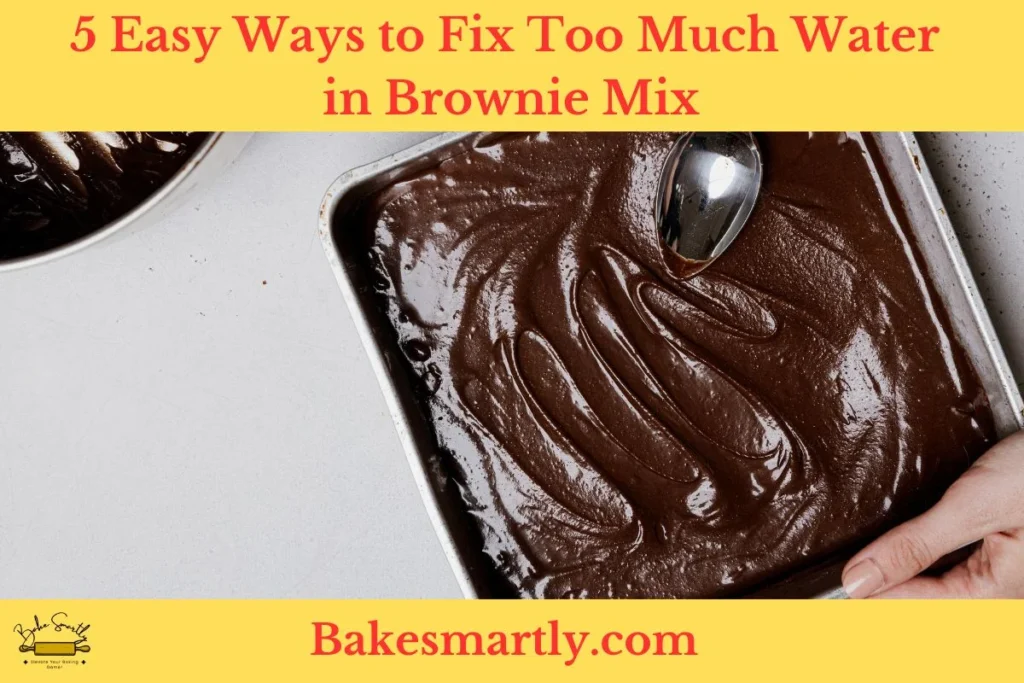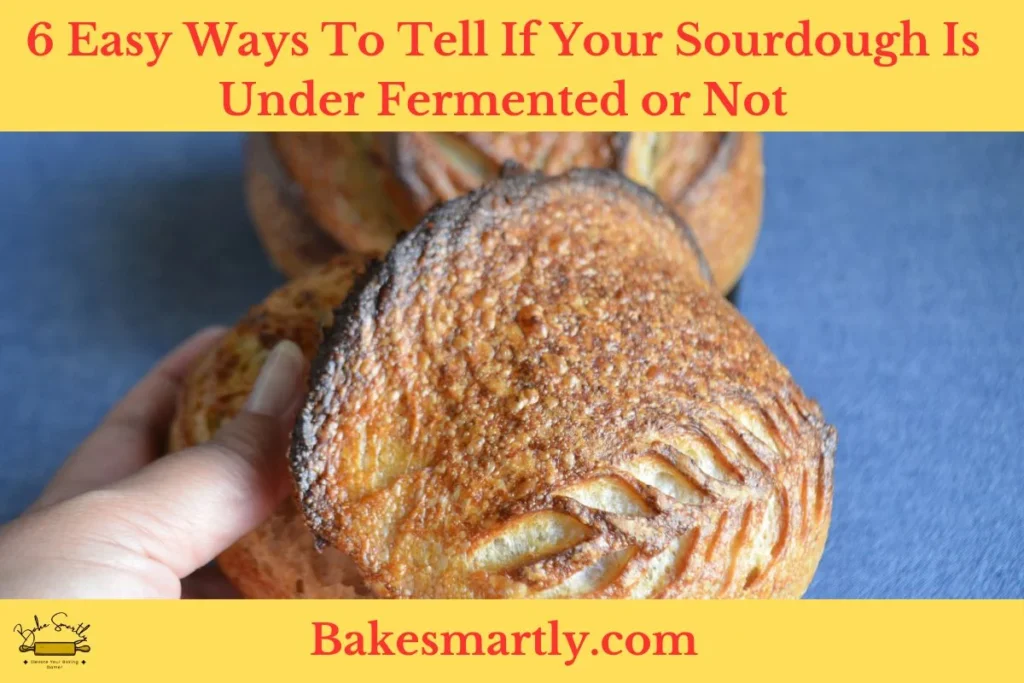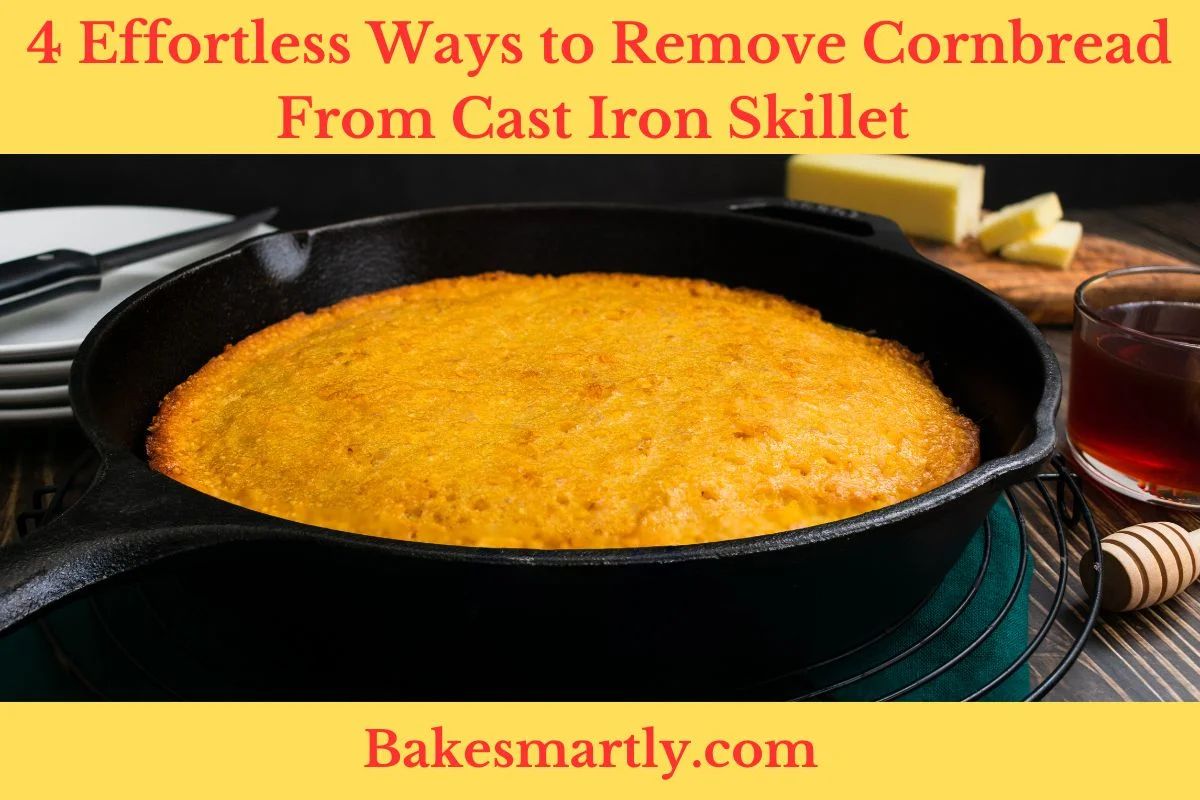
4 Effortless Ways to Remove Cornbread From Cast Iron Skillet
Cornbread, a beloved comfort food, has found its way into countless kitchens, bringing warmth and satisfaction. However, one challenge that many home cooks face is the struggle to remove cornbread from a cast iron skillet.
In this blog, we’ll look at four easy ways to tackle this common kitchen issue. We’ll also explain why cornbread often sticks to an iron skillet and give tips on cleaning the skillet after baking cornbread.
Table of Contents
ToggleWhy Cast Iron Skillets are Great for Baking Cornbread
Cast iron skillets are excellent for baking cornbread for several reasons:
- Even Heating: Cast iron can distribute heat evenly across its surface. This ensures that your cornbread bakes uniformly, with no hot spots that could result in uneven cooking.
- Heat Retention: Cast iron retains heat exceptionally well. This means that once the skillet is preheated, it maintains a consistent temperature throughout the baking process. This is crucial for achieving a golden-brown crust on your cornbread.
- Preheating Advantage: Preheating the cast iron skillet before adding the cornbread batter helps create a crispy crust. The sizzle when the batter hits the hot skillet is key to achieving that desirable texture.
- Versatility: Cast iron skillets are not just for stovetop cooking; they transition seamlessly from the stovetop to the oven. This makes them ideal for recipes that require starting on the stovetop and finishing in the oven, such as cornbread.
- Durability: Cast iron cookware is known for its durability and longevity. With proper care, a cast iron skillet can last for decades. This makes it a reliable choice for regular baking and a valuable addition to your kitchen.
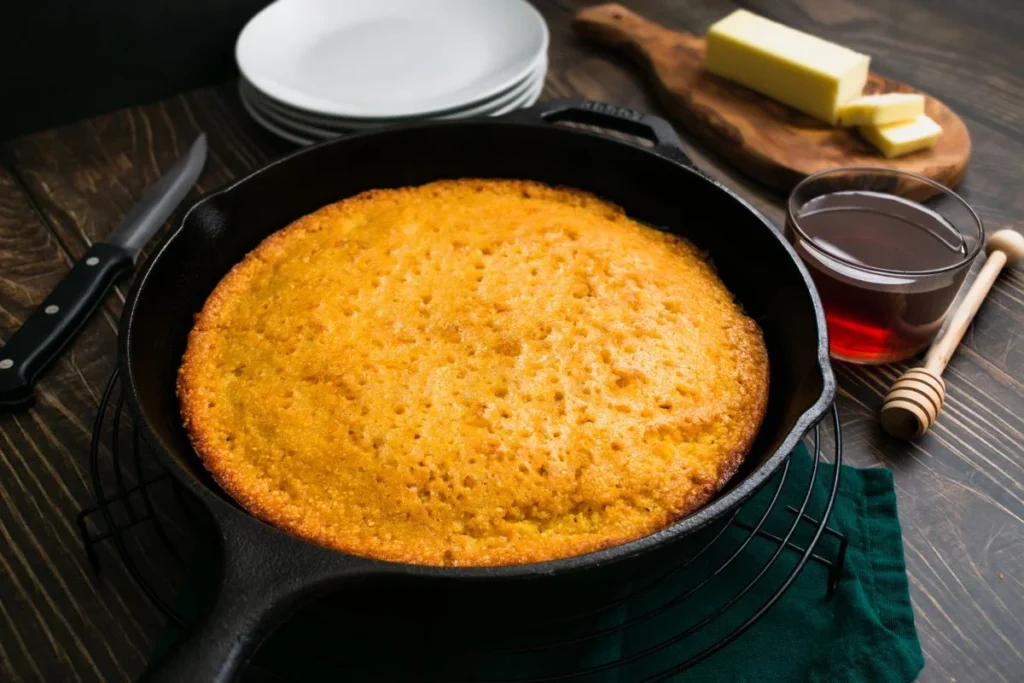
Why Does Cornbread Stick to Cast Iron Skillet?
Cornbread sticking to a cast iron skillet is a common kitchen frustration that many home cooks encounter. Understanding the reasons behind this issue is crucial for finding effective solutions and preventing it from happening in the future.
Lack of Proper Greasing
One primary reason for cornbread sticking to a cast iron skillet is inadequate greasing or seasoning. Cast iron skillets require a proper layer of oil or fat to create a natural non-stick surface.
If the skillet is not adequately greased before pouring the cornbread batter, it can lead to the bread adhering to the surface, making removal challenging.
Overheating the skillet
Overheating the skillet can also contribute to cornbread sticking. Cast iron has excellent heat retention properties, but excessive heat can cause the cornbread to cook too quickly on the surface, forming a strong bond with the skillet.
This can result in a stubbornly stuck layer that is resistant to conventional removal methods.
Cast Iron Skillet Lacks Proper Seasoning
Another factor to consider is if your cast iron skillet lacks proper seasoning or has an unevenly applied layer, the chances of cornbread sticking increase significantly.
Seasoning is not a one-time task; it needs periodic maintenance to prevent the skillet’s surface from becoming dry or losing its non-stick properties. Regularly oiling and baking the skillet helps maintain the seasoning, ensuring that your cornbread slides out effortlessly.
In some cases, variations in cornbread recipes and ingredients can also impact its tendency to stick. Cornbread with higher sugar content, for example, maybe more prone to sticking due to caramelization.
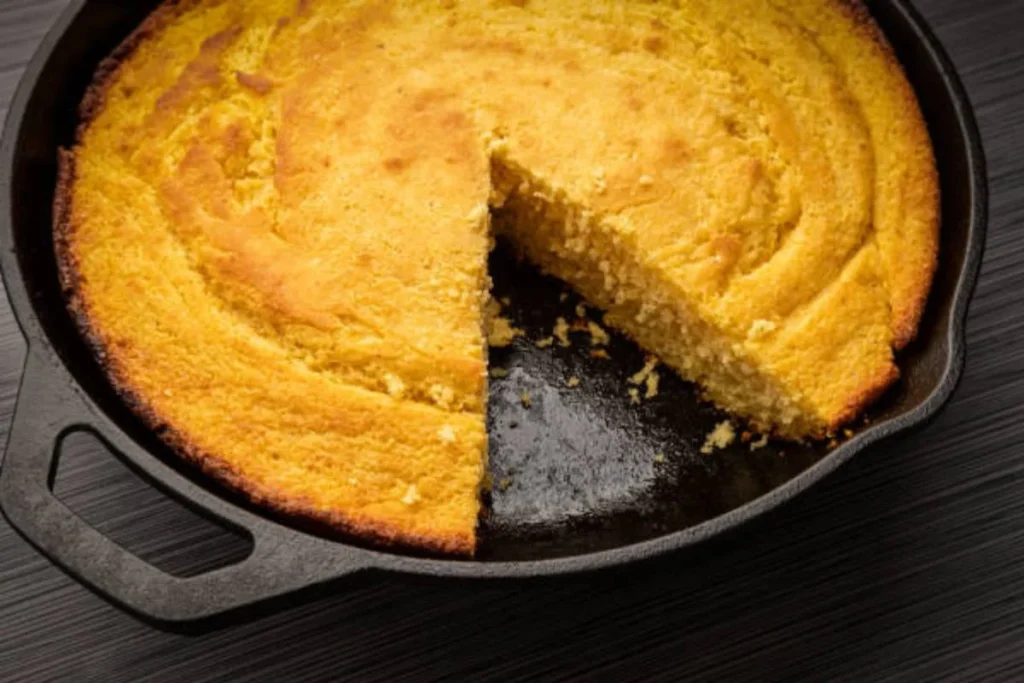
How to Remove Cornbread From Cast Iron Skillet in 4 Easy Methods
Removing cornbread from a cast iron skillet can sometimes be a bit tricky, but there are several methods you can use to make the process easier. Here are four simple methods:
Method 1: Cooling and Patience
The first method involves the simplest and most patient approach. Once you’ve taken the cornbread out of the oven, allow the skillet to cool naturally. Rushing the process may cause the cornbread to adhere more firmly.
Once it’s at room temperature, use a plastic or wooden spatula to gently loosen the edges. Gradually work your way around the skillet, applying gentle pressure.
If the cornbread is still resistant, let the skillet sit for a bit longer to allow any remaining moisture to soften the stuck portions. This method is gentle on the cast iron’s seasoning, preserving its non-stick properties for future use.
Method 2: Hot Water Bath
For those who want a quicker solution, the hot water bath method can be highly effective. While the cast iron skillet is still warm, place the bottom of the skillet in a shallow bath of hot water. The heat will help loosen the crust from the pan.
After a few minutes, use a spatula or butter knife to gently lift the edges of the cornbread, ensuring it is not stuck to the skillet. Once loosened, invert the skillet to release the cornbread onto a plate or cutting board.
Be cautious not to use extremely hot water, as it may damage the skillet’s seasoning.
Method 3: Freezing and Tapping
This unconventional yet effective method involves freezing the cornbread to create a temperature differential. Allow the cornbread and skillet to cool to room temperature, then place the entire skillet in the freezer for about 30 minutes.
The extreme cold will cause the crust to contract, making it easier to release from the skillet. After freezing, tap the bottom of the skillet on a hard surface to dislodge the cornbread.
Invert the skillet onto a plate, and with a gentle shake or tap, the cornbread should release effortlessly.
Method 4: Parchment Paper Lining
To prevent any sticking in the first place, consider lining your cast iron skillet with parchment paper before pouring it into the cornbread batter. Cut a piece of parchment paper to fit the bottom of the skillet, allowing the edges to extend up the sides.
Grease the parchment paper and sides of the skillet before pouring in the batter. Once the cornbread is baked and has cooled slightly, lift the parchment paper edges to easily lift the cornbread out of the skillet.
This method not only facilitates easy removal but also simplifies cleanup.
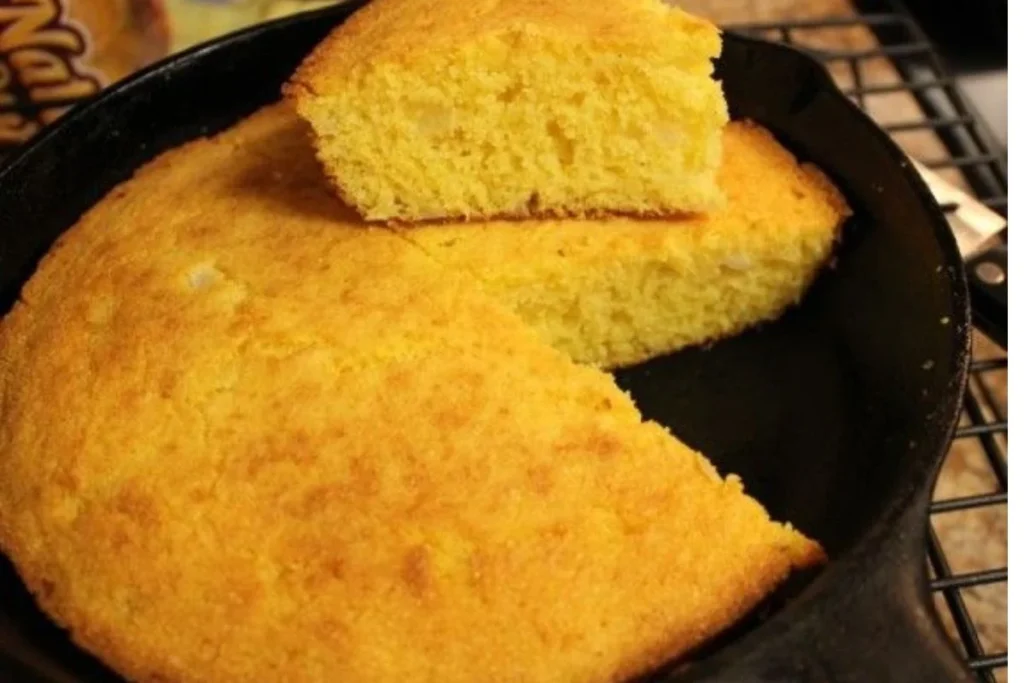
Tips for Preventing Cornbread From Sticking to Your Skillet
Cornbread is awesome and can be used in lots of ways, but it’s annoying when it sticks to the skillet. Here are some easy tips to keep your cornbread from sticking:
- Grease the skillet well: Use butter, oil, or cooking spray to coat the whole inside of the skillet, especially the corners and edges.
- Preheat the skillet: Let the skillet warm up before you add the cornbread batter. This makes a barrier between the batter and the skillet, so it’s less likely to stick. Plus, a hot skillet gives you a nice, even cook and a golden crust.
- Use a seasoned cast iron skillet: If you have one, a well-seasoned cast iron skillet naturally becomes non-stick over time. Keep it seasoned by rubbing it with oil and baking it in the oven.
- Sprinkle on some cornmeal: Before you pour in the batter, dust the skillet with a little cornmeal. This gives the cornbread a bit of crunch on the bottom and stops it from sticking.
- Tweak your recipe: Sometimes, what’s in your batter can make it stick. Play around with adding more butter or oil to make it less sticky.
- Let it cool: After baking, let the cornbread sit in the skillet for a few minutes to cool down. This helps the crust get firm, so it’s easier to get out of the skillet without falling apart.
How do I Clean the Cast Iron Skillet after Baking Cornbread?
Cleaning a cast iron skillet after baking cornbread is a straightforward process. Follow these steps to ensure your cast iron skillet stays in good condition:
- Cooling Down: Allow the cast iron skillet to cool down to a temperature that is safe to handle. Never attempt to clean it while it’s still hot.
- Scrape off Residue: Use a spatula or a flat-edged utensil to scrape off any remaining bits of cornbread or residue. Be gentle to avoid damaging the seasoning of the cast iron.
- Wash with Mild Soap and Water: Contrary to common myth, it’s okay to use a small amount of mild dish soap on your cast iron skillet. Use a sponge or soft brush to wash the skillet with warm water. Avoid using harsh scouring pads or abrasive cleaners, as they can strip away the seasoning.
- Avoid Soaking: Do not soak the cast iron in water for extended periods, as prolonged exposure to water can lead to rusting. Wash and rinse promptly.
- Dry Thoroughly: After washing, use a clean towel to thoroughly dry the skillet. Any remaining moisture can lead to rust, so make sure it’s completely dry.
- Oil or Season: To maintain the seasoning of your cast iron, you may want to apply a thin layer of cooking oil to the skillet’s surface. Use a paper towel to spread a small amount of oil evenly across the inside and outside of the skillet. This helps to protect the cast iron from rust and maintain its non-stick properties.
- Store Properly: Store the cast iron skillet in a dry place. If possible, avoid stacking other cookware inside it to prevent scratches.

Troubleshooting Frequently Encountered Issues
People who love cooking often run into some typical problems in the kitchen. It’s important to know how to fix these issues to keep your kitchen running smoothly.
Two prevalent problems that individuals often encounter involve dealing with burnt or stuck bits on cookware and restoring the seasoning of a skillet.
1. Handling Burnt or Stuck Bits
Getting burnt or stuck bits on your cast iron skillet, especially after making cornbread, happens a lot. To deal with it, start by gently scraping off any loose stuff with a spatula or wooden spoon while the skillet is still warm.
If there are bits that won’t budge, try a salt scrub. Just sprinkle some coarse salt over those areas and use a soft brush to gently scrub them away. The salt helps scrape off the gunk without hurting the skillet’s surface.
If the bits are stubborn, you can try using a paste made of baking soda to break them down without messing up the seasoning.
2. Fixing Up the Skillet’s Seasoning
As time goes on, the seasoning on your cast iron skillet might wear off or get uneven, making it less non-stick. To fix that, first, give your skillet a good wash with hot water and a mild detergent if needed.
Then, dry it off completely and put on a thin layer of vegetable oil or flaxseed oil all over, even on the handle and outside. Pop the skillet upside down in a preheated oven at 375°F (190°C) for about an hour.
This lets the oil turn into a tough layer that makes your skillet non-stick again. Keeping up with this seasoning routine will keep your cast iron skillet in great shape for a long time.
Conclusion
In conclusion, removing cornbread from a cast iron skillet doesn’t have to be a frustrating experience. By adopting these four effortless methods and implementing proper maintenance practices, you can enjoy hassle-free baking and cleaning in your kitchen.
Lindsey Mackenzie
About me
Hi there! I’m Lindsey Mackenzie, the founder of Bake Smartly. Baking has been my passion since childhood, growing up in my father’s bakery. With Bake Smartly, I’m excited to share my love for all things sweet and savory. Join me on this delicious journey as we whip up scrumptious treats and sprinkle joy into every bite!

